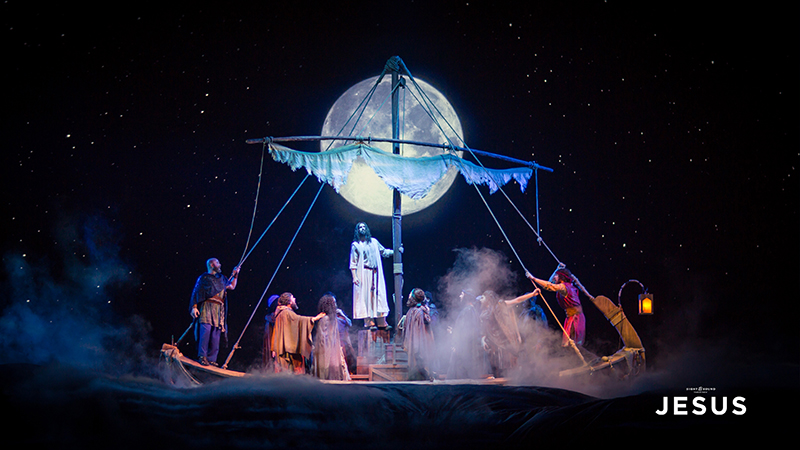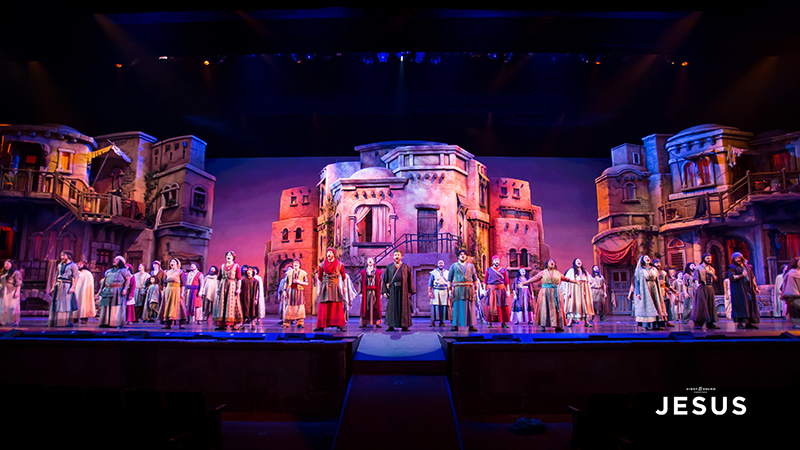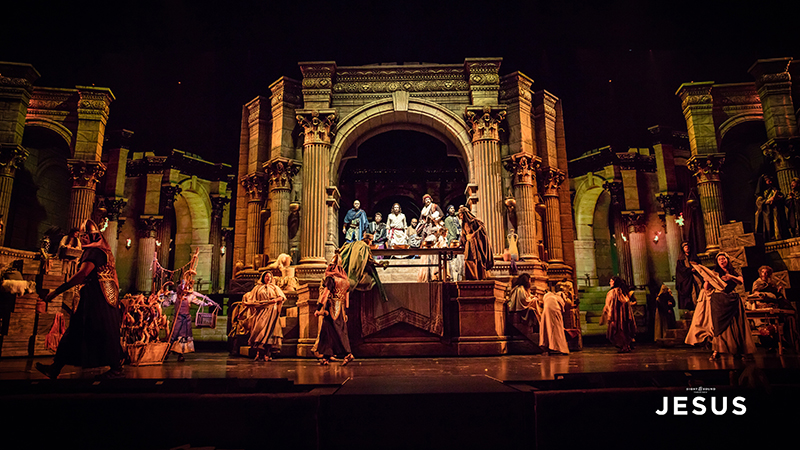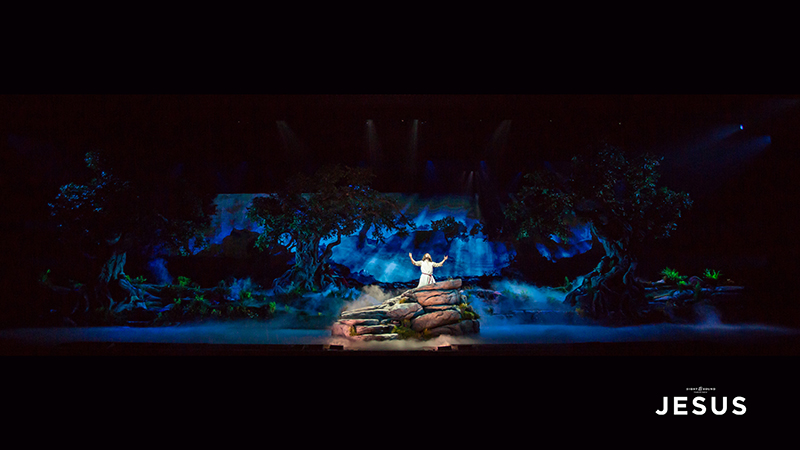
Sight & Sound Theatres Brings Scripture to Life
Ah, the pastoral landscape of Lancaster, PA. Long known as Pennsylvania Dutch Country, this county of expansive emerald hills, rod-straight hedgerows, barns painted with hex signs and quiet Amish farms provides an idyllic getaway from the daily mayhem of nearby New York City and Philadelphia. More than 8 million people visit here annually, making tourism a multi-billion-dollar industry for a place that seems to eschew the very concept of industry. Bicycle tours of covered bridges, hot air balloon rides and visits to family farms entice tourists to step off the corporate treadmill and take things slow for a day, a weekend, or a week.
That is, until they enter the palace-like Sight & Sound Theatres and take a seat in the auditorium, where the stage borders the house on three sides — effectively surrounding the audience in a multi-sensory experience that rivals the Broadway stage. Here the Judeo-Christian Bible comes to life, taking the grandest stories from beginning to end in celebration of religion’s most iconic heroes. More than 1 million people annually enjoy a production here and in Sight & Sound’s second location in Branson, MO, a testament to the theater’s ability to tell a terrific story.
In bringing the Bible to the stage, producers have big expectations to meet. Cecil B. DeMille set the standard for sweeping Biblical epics with his extraordinary films The King of Kings, Samson & Delilah, The Ten Commandments and Cleopatra — not a Bible story, but of the same era in history — and Hollywood piled on with The Robe, Ben-Hur, The Greatest Story Ever Told, Solomon and Sheba, Spartacus and dozens of others. How can live theater match the casts of thousands, the endless landscapes and the overall pageantry of such classics? The answer, according to Sight & Sound, is to create an immersive live experience that makes the audience feel as if they are really watching Noah build an ark, Moses part the Red Sea, or Samson break down a wall.
The featured production on Sight & Sound’s stage for 2019 is Jesus, a story that spans the adult life of the savior, with his childhood and young adulthood portrayed in flashback scenes. Once the theater’s management decided that it was time to bring this gospel New Testament story to the stage, executive producer Josh Enck took the design and story teams on a visit to Israel to see the actual landscape on which the events in Christ’s life took place.
“Josh just came home bursting with energy,” said Katie Miller, Sight & Sound corporate communications director. “He was so excited by the colors he saw — the beautiful hillsides along the sea of Galilee, the bright flowers, even the fabrics and the colors of the town. He wanted to represent the landscape. He said, ‘You can stand on the shore of Galilee and see for miles. How will we recreate the depths and colors of this landscape?’”
Thus began a three-and-a-half-year period of scriptwriting, visualization and design, the standard interval that Sight & Sound devotes to bringing a story to life. “We have 650 employees in two locations,” said Miller. “We are so honored and privileged to be able to design and produce our shows in-house with our incredibly talented team.”
Every part of the production originates at Sight & Sound, from writing an original script to scenic, lighting, costume and projection design. There’s even a team that composes original music for each production. “We have a whole construction team as well,” Miller added, in addition to the crew that runs the actual performances.

Breaking Down the Years
“The first 12 months are in-the-sky, out-of-the-box,” said Glen Brodersen, Sight & Sound technical director, who helps to oversee the design and build processes. “But because we’re actually building and designing everything at the same time, there’s never a time when we say, ‘Okay, everything’s designed, we can build it all.’ We try to look at it holistically, from a story perspective. What are the parts that we can start to workshop? We get different people in the room with their skills and interests, who have different ideas about how to tell the story the best way.”
Roughly 75 people take part in the creative and design process, Brodersen said. “There are core teams involved in that process, working with the producer and director very early. It’s me, the line producer, the artistic director and the production manager giving the support on the early story development, asking if there’s anything they need us to chase, to work through. Then we start adding the designers to the story process about six months in. There’s a 3D artist and a 2D artist working through renderings. Then we add the props designer, the costume designer. But from the artist’s perspective, there’s a lot that happens in the 3D world, working with the white modeling of the show.”
For Jesus, the many scenes of the savior’s life range from sunlight on the wildflower-covered hills at the Sermon on the Mount to the towering, ornately carved walls of the temple where merchants and moneylenders hold sway. Scenes at sea, where Jesus and Peter walk on water, require crashing waves around a ship that glides across the stage in an electrical storm. Nightfall on a candlelit city, twilight on the garden at Gethsemane and even the docks at Capernaum required detailed planning to create a sense of realism that sweeps audiences into the grandeur of these well-known moments in the Gospels.
“It gets to a point where one artist can’t handle all the pieces,” said Brodersen, “and that’s when the group starts to explode.”
Scene design teams including an artist and an engineer work as a pair on a single set, with the assistance of technical staff members who can advise on the practical methods required to bring ideas to fruition. The theater has an impressive array of options available to make miracles happen onstage, beginning with a Raynok show control system, which handles the movement of drops, wagons, set pieces and performer flying, and an iTrax system that communicates with Raynok and vehicle motors to bring each piece to the exact place it belongs. Jesus features an impressive 254 SMPTE-coded show control events, so the Raynok system proves its worth in every performance.
A massive INFiLED QE series LED screen stretches 114 feet across the farthest upstage position, reaching 28 feet high to fill the entire proscenium. Weighing more than 20,000 pounds, the screen requires a custom-built Tait lineshaft hoist with a 25,000-pound capacity, which flies the screen out periodically during each performance to make room for major scene changes. “It flies the screen 31 feet in about 20 seconds,” said Brodersen.
Having this full-stage projection capability allows the theater to forego painted backdrops and cycloramas while creating brilliantly colored video scenes, essentially engulfing the actors in dramatic moving images. The scene design team creates these effects using Adobe Photoshop, Modo, disguise and After Effects programs.
The theater’s video rig includes 12 Nova-
Star MCTRL660 screen controllers and a second set of identical controllers for redundancy, a Lightware MX-FR65R matrix frame with DVI input modules and fiber output modules, two disguise 4×4 Pro and one disguise 2×4 Pro video servers and six Digital Projection Titan 20k projectors.
The precision provided by the Raynok and iTrax systems allows the crew to project video onto moving set pieces without requiring digital synchronization between the sets and the projectors, Brodersen said. “We project where it’s going to end up,” he said. The success of this method becomes immediately apparent while Jesus and Peter, on a boat in the Sea of Galilee, leave the ship in the midst of a violent storm to walk across the water. Waves roll and break all around them and bolts of lightning stream across the darkened sky, while the two men seem to perform a miracle in front of the audience. Wind and rain effects reach beyond the stage to the audience, immersing them further into the action.
When the scenic designs are largely finalized, the production team uses Modo, a 3D modeling and rendering program offered by Foundry, and a program developed in-house to previsualize the set on the stage, Brodersen said. “We can see a 3D model in the theater and look at drops and sets and different angles for scenes and how they play,” he said. “We also use Unity, a gaming engine, to previsualize all the logistics.”
A team of animators use this combination of technology to visualize all of the crew positions, cart movements and the movement of all the animals — yes, live animals; more on that in a moment — before anyone sets foot onstage. “I’d say every 10 to 12 minutes, we’re doing a large-scale transition,” said Brodersen. “Previsualizing really makes things run more smoothly once we’re onstage.”
The show finally reaches the stage in January, after the Christmas show, Miracle of Christmas, closes at the end of December. “A brand-new premiere show will be on stage approximately 10 weeks later,” Brodersen explained. “About four weeks of that is striking the current show. It takes 45 to 55 tractor-trailer trucks to ship a show to Branson. Their shows run for two years, so it will be about a year before they get this one onto their stage.”

Lighting Jesus, Live on Stage
Lighting the production takes a team as well, said Tyler Duffy, lighting design manager. The team he oversees includes two lighting designers, an associate designer, a master electrician and an associate electrician who handles most of the show programming. Their involvement in mounting a new show comes about a year into the scenic design process.
“We walk through the whole process with everybody,” said Duffy. “The designer and associate sit down with a 3D model and import it into Vectorworks, and lay out what the scene design will be. Generally in the spring of the year before the show opens, we start actually plotting the show. Then we move it into WYSIWYG,” the lighting design and previsualization program from Cast Group of Companies, Inc., which allows designers to see what their lighting will look like on the set before tech begins. This gives the designer the ability to set cues off-site, making the tech more efficient. “It’s obviously not seamless in terms of colors and focus, but the show is pretty much fully cued, with about 10 percent of it needing changes.”
The WYSIWYG program interfaces with the theater’s ETC EOS Classic, which serves as the primary lighting console. An EOS RPU stands ready as a backup console. The lighting inventory provides a mix of conventional and LED fixtures in quantities that would strike envy into the hearts of most designers: more than 1,500 fixtures including hundreds of ETC Source Fours and Source Four PARs, cyc lights and strobes; Color Force border and cyc lights, Altman Fresnels and micro floods, American DJ, Cineo Matchstix and Chroma-Q Color Force LED fixtures; and Claypaky Alpha Profile, Spot and Wash automated fixtures.
When it turned to figuring out a way to get DMX to all the moving set pieces wirelessly, the nod went to the best in the business. “RC4 is used for lighting control in our numerous battery operated sets along with wireless LED practicals such as fire bowls, sconces and handheld lanterns & lamps,” said Duffy. “The lighting team finds the RC4 system to be reliable and easy to use.”

Animals, as Promised!
Every Sight & Sound production includes key appearances by live animals, often bringing them out into the house on ramps and walkways. Some human characters ride horses onto the stage, farm animals play roles in Miracle of Christmas and everything from pigs to camels brings additional realism to the shows.
“Animals are a huge part of our theater experience and one that is very special to us,” said Miller. “It is certainly an undertaking, for sure, but it’s also a part that brings the story to life.”
Permanent residents at Sight & Sound, the animals are treated with the same level of care that human actors would expect, she said. “We have our animal caretaker team that makes sure they are fed and exercised and that they receive their health care. We have a training team working on training the animals for our upcoming shows. We have our handling team that works with them onstage.”
Actors and animals work together closely to become accustomed to one another, a process that takes time but that builds trust between them. “Sometimes the actors and actresses are riding the animals, but we mostly try to keep them in contact with the people who have trained them, who they are comfortable with,” said Miller. “If it’s going to be an actor, they work together to achieve that.”
Overall, said Miller, nothing in the productions is done simply for the sake of creating fabulous effects. “It’s all about telling the story — we never want to be spectacular just to do it,” she said. “We want to enhance and tell the story. We know that we can’t take credit for these stories, they’ve been changing lives for thousands of years. We hope that what we do allows people to connect at a deeper level with scripture. Jesus was the original storyteller! If we can do these stories justice, and we can inspire people to connect every day with scripture, then we have done what we have meant to do.”

Jesus, Live on Stage at Sight & Sound Theatres
Gear
Lighting:
Automated Fixtures:
- 22 Claypaky Alpha Profile 1200
- 15 Claypaky Alpha Profile 1500
- 44 Claypaky Alpha Spot HPE 1200
- 26 Claypaky Alpha Wash 1200
- 1 Claypaky Alpha Wash 1500
- 5 Martin MAC Axioms
- 13 Robe DL4S Profile
LED Fixtures:
- 13 Chroma-Q Color Force 12 Border
- 12 Chroma-Q Color Force 12 Cyc
- 12 Chroma-Q Color Force 72 Border
- 10 Chroma-Q Color Force 72 Cyc
- 9 ADJ H20 Pro DMX
Conventional Fixtures:
- 83 10° ETC Source Fours 575W
- 18 10° ETC Source Fours 750W
- 33 14° ETC Source Fours 575W
- 7 14° ETC Source Fours 750W
- 126 19° ETC Source Fours 575W
- 40 19° ETC Source Fours 750W
- 155 26° ETC Source Fours 575W
- 10 26° ETC Source Fours 750W
- 37 36° ETC Source Fours 575W
- 9 50° ETC Source Fours 575W
- 3 70° ETC Source Fours 575W
- 1 90° ETC Source Fours 575W
- 51 ETC Source Four Par VNSP 575W
- 24 ETC Source Four Par NSP 575W
- 103 ETC Source Four Par MFL 575W
- 132 ETC Source Four Par WFL 575W
- 61 ETC Source Four Par XWFL 575W
- 11 Strand Coda Cycs
- 6 Single Cell Sky Cycs
- 20 3-Cell Sky Cycs
- 4 Diversitronics Mark II Strobes
- 2 Martin Atomic 3000 Strobes
Followspots:
- 10 RJ Super Korrigan
- 2 RJ Victor
- 2 RJ Lucy
Other:
- 5 4” Wybron Forerunner Scrollers
- 72 7” Wybron Forerunner Scrollers
- 10 Single Gobo Rotators
- 4 Ultratec Radiance Hazers
Video:
- 1 Custom InfiLED QE series 3.91mm pitch LED screen (114 feet x 28 feet).
- 24 NovaStar MCTRL660 screen controllers
- 1 10gig fiber for signal distribution to the screen controllers
- 1 Lightware MX-FR65R matrix frame with DVI input modules and Fiber Output
- 2 disguise 4×4 Pro video severs
- 1 disguise 2×4 Pro video server
- 6 Digital Projection Titan 20K projectors


